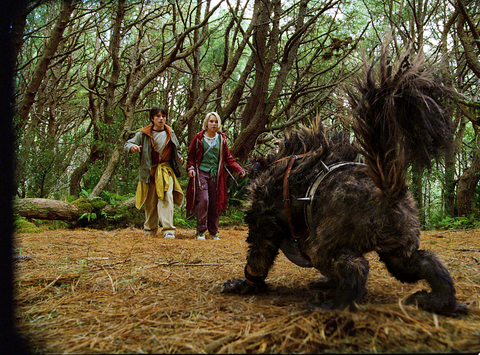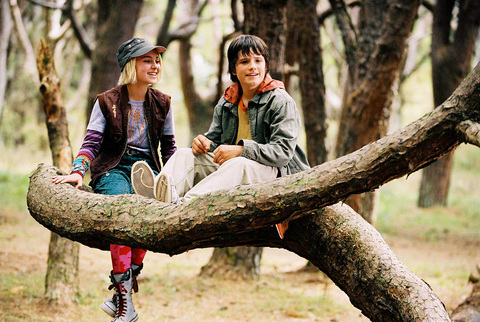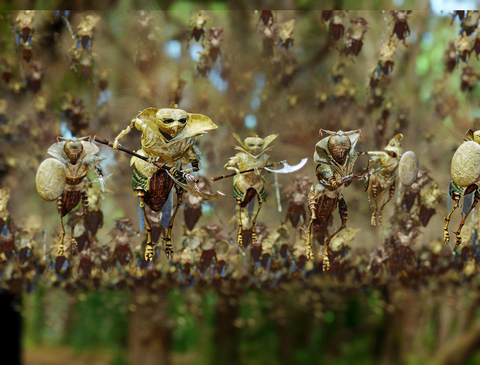Despite an ad campaign suggesting wall-to-wall special effects, Bridge to Terabithia is grounded in reality far more than in fantasy. Adapting Katherine Paterson's award-winning novel, the screenwriters David Paterson (Ms. Paterson's son) and Jeff Stockwell have produced a thoughtful and extremely affecting story of a transformative friendship between two unusually gifted children. The result is a movie whose emotional depth could appeal more to adults than to their offspring.
Jess Aarons (Josh Hutcherson) is a sixth grader with four sisters, financially strained parents (Robert Patrick and Kate Butler) and a talent for drawing. An introverted kid who is regularly picked on by the school jerks, Jess forms a bond with a new student named Leslie (AnnaSophia Robb), a free spirit whose parents, both writers, are fondly neglectful. An attraction between outsiders, their friendship feeds on her words and his pictures; together they create an imaginary kingdom in the woods behind their homes, a world they can control and where their minds can roam free.
Beautifully capturing a time when a bully in school can loom as large as a troll in a nightmare and the encouragement of a teacher can alter the course of a life, Bridge to Terabithia keeps the fantasy in the background to find magic in the everyday. Gabor Csupo, one of the creators of Rugrats, directs this, his first feature, like someone intimate with the pain of being different, allowing each personality more than a single characteristic and reveling in tiny, perfect details: the mending tape hugging a worn pair of sneakers, the way a child detects the tension in a parent's hushed conversation, the inchoate isolation of a lone boy in a house filled with the sounds of women.

PHOTOS COURTEY OF CMC
With strong performances from all the leads, including Zooey Deschanel as a spirited music teacher and little Bailey Madison as Jesse's youngest sister, May Belle, Bridge to Terabithia is able to handle adult topics with nuance and sensitivity. As the emotional landscape darkens, those who haven't read the book may be surprised at the sorrow the filmmakers evoke without ever resorting to shock or sentimentality. In other words, your children may sniffle, but they won't be traumatized.
Consistently smart and delicate as a spider web, Bridge to Terabithia is the kind of children's movie rarely seen nowadays. And at a time when many public schools are being forced to cut music and art from the curriculum, the story's insistence on the healing power of a nurtured imagination is both welcome and essential.




On April 26, The Lancet published a letter from two doctors at Taichung-based China Medical University Hospital (CMUH) warning that “Taiwan’s Health Care System is on the Brink of Collapse.” The authors said that “Years of policy inaction and mismanagement of resources have led to the National Health Insurance system operating under unsustainable conditions.” The pushback was immediate. Errors in the paper were quickly identified and publicized, to discredit the authors (the hospital apologized). CNA reported that CMUH said the letter described Taiwan in 2021 as having 62 nurses per 10,000 people, when the correct number was 78 nurses per 10,000

As we live longer, our risk of cognitive impairment is increasing. How can we delay the onset of symptoms? Do we have to give up every indulgence or can small changes make a difference? We asked neurologists for tips on how to keep our brains healthy for life. TAKE CARE OF YOUR HEALTH “All of the sensible things that apply to bodily health apply to brain health,” says Suzanne O’Sullivan, a consultant in neurology at the National Hospital for Neurology and Neurosurgery in London, and the author of The Age of Diagnosis. “When you’re 20, you can get away with absolute

May 5 to May 11 What started out as friction between Taiwanese students at Taichung First High School and a Japanese head cook escalated dramatically over the first two weeks of May 1927. It began on April 30 when the cook’s wife knew that lotus starch used in that night’s dinner had rat feces in it, but failed to inform staff until the meal was already prepared. The students believed that her silence was intentional, and filed a complaint. The school’s Japanese administrators sided with the cook’s family, dismissing the students as troublemakers and clamping down on their freedoms — with

As Donald Trump’s executive order in March led to the shuttering of Voice of America (VOA) — the global broadcaster whose roots date back to the fight against Nazi propaganda — he quickly attracted support from figures not used to aligning themselves with any US administration. Trump had ordered the US Agency for Global Media, the federal agency that funds VOA and other groups promoting independent journalism overseas, to be “eliminated to the maximum extent consistent with applicable law.” The decision suddenly halted programming in 49 languages to more than 425 million people. In Moscow, Margarita Simonyan, the hardline editor-in-chief of the